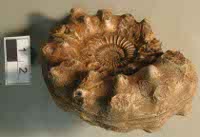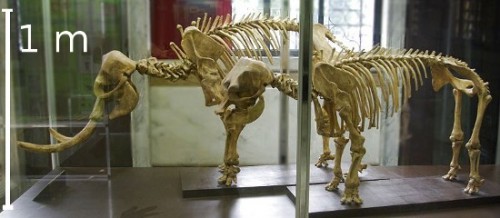…di Davide Bertè 5 marzo 2011
Se fate una passeggiata sulle Dolomiti o su molte montagne italiane e straniere è possibile che vi imbattiate in Ammoniti fossili.

Oggi queste conchiglie vengono interpretate come resti di organismi vissuti un tempo molto lontano, fossilizzati e giunti fino a noi. Ci sembra ovvio, eppure non è stato sempre così. Un tempo le Ammoniti erano chiamate pietre serpente, pietre di drago, ecc. Pur potendo fare le nostre stesse osservazioni, le conclusioni che hanno tratto i nostri antenati erano molto diverse.
Eccovi alcuni esempi.
I ciclopi. Nell’Odissea Omero racconta come Ulisse riuscì a scappare da Polifemo, un essere gigantesco con un occhio solo, che voleva mangiarsi l’eroe greco. Oggi si ritiene che all’origine del mito potrebbe esserci il ritrovamento fortuito, sulle coste della Sicilia, di un cranio di Elephas falconeri.

Le aperture nasali, che formano un unico foro, sarebbesro state interpretate come un’unica cavità oculare. Oggi sappiamo che si tratta di un elefante nano (~1 m di altezza) discendente dal più grande Elephas antiquus (~3,5 m di altezza) vissuto nel Pleistocene medio. E. falconeri, pur essendo passato dal mondo mitico al mondo storico, è ugualmente famoso come esempio di nanismo insulare. Quando una specie continentale arriva su un’isola tende a ridurre la taglia. In un ambiente dalle risorse limitate, senza predatori, un individuo di taglia minore sarà avvantaggiato rispetto a uno di taglia maggiore. È un fenomeno che si osserva comunemente sulle isole e anche l’uomo ne è soggetto (vedi l’Homo floresiensis indonesiano).
I draghi. Andando per grotte è possibile ritrovare ossa di animali preistorici, anche molto grandi. Un tempo queste venivano spesso interpretate come ossa di drago. Uno dei casi piú famosi è quello di Klagenfurt in Carinzia (Austria). Nella piazza principale sorge un monumento con un drago, simbolo della città. È dimostrato che Vogelsang, che scolpì il monumento alla fine del ‘500, utilizzò come modello un cranio di rinoceronte lanoso, Coelodonta antiquitatis, rinvenuto nella Fossa del Drago.

Ma quando fu che i fossili cominciarono a essere interpretati come vestigia di un passato storico e non mitico? Esiste una data precisa: il 1669. Quell’anno veniva infatti stampato ‘De solido intra solidum naturaliter contento dissertationis prodromus’ (Dissertazione preliminare di un solido naturalmente incluso in un altro solido) di Nicola Stenone. Stenone si trovava a Firenze presso Ferdinando II de’ Medici e ricevette da studiare una testa di squalo pescato a Livorno. Esamindola notò che i denti di squalo erano identici alle cosiddette glossipetrae (lingue di pietra). Oggi sappiamo trattarsi di denti di squalo fossili ma all’epoca non lo si sapeva ancora. Stenone riconobbe la somiglianza e dedusse correttamente che, poiché i fossili avevano lasciato la loro impronta nelle rocce circostanti, dovevano essere solidi prima che il sedimento circostante si consolidasse. Le rocce non furono create con la Terra, ma si solidificarono in un secondo momento. Stenone stava gettando, contemporaneamente, sia le basi della paleontologia che della geologia moderna!
Il fatto di riconoscere i fossili come resti di organismi nel passato però non volle automaticamente dire saperli sempre interpretare correttamente.
L’uomo del diluvio universale. Nel 1726 Scheuchzer nella sua Litographia Helvetica descrisse un bacino umano come evidenza storica del diluvio universale e lo chiamó Homo diluvii testis. Nel 1812 Cuvier, uno dei più gandi anatomisti della storia, esaminò il reperto e scoprì che in realtà si trattava… di una salamandra gigante! Oggi è inserita nel genere Andrias (dal greco = uomo) a memoria della prima interpretazione. Per la cronaca: il genere Andrias non è affatto estinto e in Giappone e in Cina sono ancora presenti delle specie (Andrias japonicus e Andrias davidianus).
L’uomo di Piltdown. La pubblicazione de l’Origine delle specie (1859) portò scompiglio nella comunitá scientifica. Darwin parlò di forme transizionali da una specie all’altra ma che non si erano conservate a causa della difficoltà di fossilizzazione. Nel 1860 Hopkins coniò il termine anello mancante: una specie intermedia tra una forma “primitiva” e una “evoluta” (il concetto di anello intermedio attualmente è caduto in disuso: ogni organismo è adattato al suo ambiente e non è la forma di transizione verso nessun’altro organismo futuro). In effetti quello stesso anno venne rinvenuto Archaeopteryx litographica, prova del passaggio dai dinosauri agli uccelli. Archaeopteryx non era un uccello perfetto, ma presentava caratteri “primitivi” (denti, sterno non carenato) accanto a caratteri “evoluti” (penne). Era evidente che doveva esistere anche una forma intermedia tra la “scimmia” e l’uomo. L’ansia di trovare questo anello intermedio ebbe termine quando nel 1912, a Piltdown (Sussex, Inghilterra), venne rinvenuto Eoanthropus dawsonii (l’uomo dell’alba di Dawson, lo scopritore). Il reperto era un perfetto mix di caratteri primitivi ed evoluti: a una mandibola scimmiesca infatti era associato un cranio che testimoniava un cervello di grandi dimensioni. Troppo perfetto… Ci vollero quarant’anni a smascherare la frode ma, ancora oggi, non si sa chi dei tre scopritori fu colpevole (Dawson, Tehillard de Chardin o Woodward). Nel 1953 il British Museum eseguì una datazione basata sul contenuto di fluoro, uranio e azoto nel reperto e stabilì che l’uomo di Piltdown era l’assemblaggio di una mandibola di orango (invecchiata artificilamente con biocromato di potassio e con i denti limati a imitare una usura come quelle degli umani) con un cranio di un umano moderno di epoca storica.
Quali conclusioni trarre da queste storie?
Se le interpretazioni dei fossili come ossa di drago o di ciclope ci fanno sorridere e ci sembrano ingenue, le altre due ci devono invece far riflettere. Non dobbiamo pensare, per il semplice fatto di avere il vantaggio di giudicare con il senno del poi, che chi ha elaborato altre spiegazioni nel passato fosse uno sciocco; semplicemente incasellava le osservazioni che faceva in base alle conoscenze dell’epoca. Le classificazioni sono lo specchio delle nostre concezioni, del nostro pensiero. Il fatto di credere che ci sia stato il diluvio universale porta a interpretare tutti i fossili come risultato di questo evento, il fatto di credere nell’esistenza di anelli intermedi ci porta a prendere per buoni dei falsi. La buona Scienza, però, è quella che si basa sulle osservazioni, mette in discussione le interpretazioni e corregge i propri errori, portando a una migliore comprensione della Natura.
Bibliografia:
Gould S.J. 1980 Il pollice del panda. Anabasi.
Gould S.J. 1984 Quando i cavalli avevano le dita. Feltrinelli.
Renfrew C. e Bahn P. 2006 Archeologia. Zanichelli.
Halstead B. 1974 Evoluzione dei vertebrati. Boringhieri.
Thenius E. 1975 Testimonianze fossili. Boringhieri.
Molto interessante Davide!
Fa riflettere e ci ricorda di stare sempre in guardia…
Bravo!